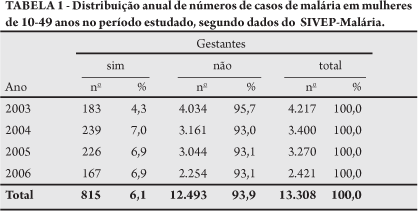INTRODUCTION: The SIVEP-Malaria Epidemiological Surveillance Information System has been in use for notification of malaria cases diagnosed in Brazil since 2003. This study analyzed malaria cases notified among women aged 10 to 49 years between 2003 and 2006, according to the presence or absence of pregnancy. METHODS: Authorization to evaluate the data was requested from the Health Surveillance Foundation (FVS). RESULTS: Over this period, 13,308 malaria cases were notified, of which 815 (6.1%) were among pregnant women. There was a gradual decrease in the absolute numbers of cases among pregnant and non-pregnant women. Regarding species, 14.3% of the notified cases were caused by Plasmodium falciparum; 85% by Plasmodium vivax and 0.6 % by both of them. The frequency of Plasmodium falciparum infection was greater among pregnant women than among non-pregnant women (p > 0.05). Although most of the cases lived in the eastern zone of the city, the western zone appeared to be the likely location of infection in 39% of the cases. Endemic peaks of malaria in July and August were observed among the non-pregnant women in all four years analyzed. CONCLUSIONS: The data showed that SIVEP-Malaria was an important tool for determining the distribution of malaria cases and that it should be used for controlling the endemic disease. However, the data from its first four years of operation showed that the quality was compromised by data entry failures, using the field of notification of pregnancy as an example.
Malaria; Pregnant woman; Plasmodium sp; Risk factors; Amazonas





